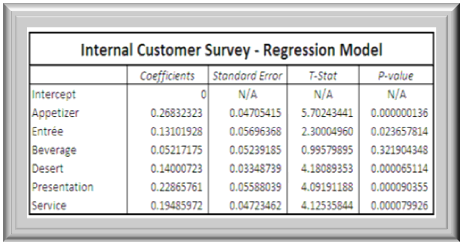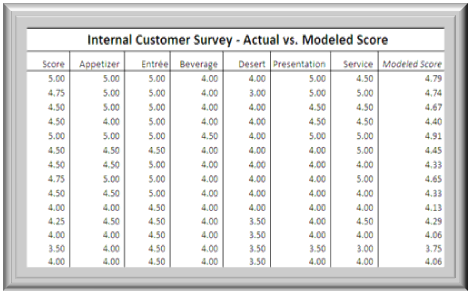Chapter 1 (from the Book)
Why
Demographic Analysis is so Critically Important in Planning Locations and Menus
While the vast majority of
large restaurant chains employ qualified market researchers and quantitative
analysts, working with in-house Chefs and testers to plan, develop, and
optimize menus, most non-chain and smaller restaurant chains are generally
financially constrained from taking that robust research route, and instead
rely, at best, on focus groups and internal customer surveys to tweak their
menus.
Most focus groups are far
less consequential than statistically significant market surveys, while internal
customer surveys require sophisticated data tabulation and mining, often
packing them to collect dusts. For example, a mere 30 responses a day over a
60-day period will require the help of a data analyst and statistical software
to tabulate, analyze, and model the data. If the menus are seasonal, the data
collection must be repeated across seasons, necessitating even more
sophistication.
Many successful non-chain
restaurants located in busy tourist areas or demographically cross-sectional
neighborhoods suddenly face disappointment when they try to duplicate that
successful “central” format in other parts of the city with vastly different
demographics.
John Doe is a very
successful restaurateur owning and operating a sit-down lunch and dinner
restaurant in a touristy city center. He and his banker agree that the success
of this restaurant should be duplicated in other parts of the city, so John
decides to open two more – one in the vibrant eastside across from a large
State College campus and another in the thriving westside in close proximity to
a wealthy retirement community. He has seen success and hence believes in his
proven format, including holding his current menu constant for the new
locations.
Suddenly, a bolt from the
blue.
His Chief Chef is leaving.
Due to family reasons, he has decided to return to the west coast. John Doe is
nonetheless adamant that he will not abandon his expansion plans. He contacts
his banker friend, who suggests ChefQuant Consulting Services. While he is not
too thrilled about the suggestion, considering he knows his business inside and
out, he reluctantly stops by their office and meets ChefQuant to start the
dialogue. Knowing John is looking to fill the vacancy, ChefQuant invites
Priya, a recent graduate at the top of her class from the local culinary
school. Before the interview, ChefQuant explains to John that Priya belongs to
a new generation who is not only culinary trained but is also data smart,
although she lacks the experience of heading a restaurant yet. John is shocked
(he was looking for a well-known Chef with at least ten years of culinary and
management experience).
John returns to office and
speaks to his banker friend who encourages him to take ChefQuant’s advice very seriously.
Under a bit of pressure and a feeling of despair, John decides to hire Priya as
his Head Chef. While Priya will be working out of the central location, she
will be running the two new locations with resident Assistant Chefs and
monitoring their operations via live video feeds.
Priya comes on board in a
week and starts working with the departing Chef.
A week later, ChefQuant
holds his first business meeting with John and Priya. Right at the outset, John
makes it adamantly clear that he would not change a thing when it comes to his
successful menu and even the interior décor for his new locations. While ChefQuant
did not have any specific survey data for John’s new locations, he puts forth
the following citywide survey summary (median) broken down by age groups, politely
emphasizing that the eastside location will primarily cater to the Gen-Y
(college students) while the westside location will attract mostly Baby Boomers
and Seniors 70+.
 |
| (Click on the image to enlarge) |
The summary shows these two
groups’ tastes and preferences are quite different from the overall medians
that his central location is perhaps relying on. ChefQuant therefore emphasizes
to John that the existing menu has to be meaningfully tweaked in line with the
actual survey data and the resulting analyses, with the possibility of several
menu items being adjusted, changed or even swapped.
John looks at Priya and
wants her suggestion. She says, “Given the divergence in the data, I totally
agree with ChefQuant. In fact, once the actual east and west survey data and
analyses come in, I suspect they will show even more polarized results than
what I see in this citywide summary, potentially prompting significant changes to
our central menu. The Gen-Y’s taste for salt and sweet is noticeably higher
than the overall medians, though they don’t care for bitter at all. Conversely,
BBs and Seniors prefer lower salt and sugar, but are unafraid of bitter.
For example, the appetizer sampler for the west may require a swap like
roasted Chinese Bitter Melon with tangy garlic sauce while the east may enjoy a
salty and spicy Indian Samosas with sweet Middle Eastern date sauce.”
Priya continues, “By the
way, I have been tabulating the recent internal customer surveys for this location
in order to understand if there is any disconnect between what we offer and
what our customers are truly interested in. I am seeing certain gaps I need to
gradually fill in. The culinary business is not all-art anymore. It now
requires a good dose of science. For example, this simple correlations matrix
tells me how to couple a main ingredient with a complementary sauce.”
John then concludes the
meeting by sharing an episode from his college days, “I was a good student,
majoring in business. I was so confident of myself that in the final semester I
proudly signed up for a class called Applied Finance. To make the long story
short, after the third class I had to drop out like a wet cat. The class was
nothing but complicated math and the freaking professor was from the Math Dept.
I was wondering if I’m looping back into a similar situation, again?”
They will meet in a month
after ChefQuant’s marketing team collects and analyzes the targeted survey
data.
____________________________________________________________






